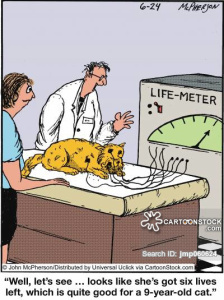LIFE STAGES: WHEN YOUR KITTY GETS SICK

‘Well, let’s see… looks like she’s got six lives left, which is quite good for a 9 year old cat.’
Good news! Cats are living longer now. Better food and living conditions, keeping cats indoors, and an improved general understanding of cats have all played their part in stretching a normal cat’s life from 12 to 16 and even up into the 20s. There can be a downside to this increased longevity, however. Because cats lead safer lives, they are now more susceptible to the health issues that come with their extended years.
Arthritis: Like us, your cat’s joints stiffen and wear down after a lifetime of leaping up cat trees and jumping onto beds, tables, and counters. Arthritis is one of the most common ailments affecting middle aged to senior cats. Arthritis occurs when a joint is unstable causing the bones to move abnormally within the joint. Over time this abnormal movement erodes the cartilage and bone begins rubbing against bone creating chronic inflammation and pain.
Dental disease: Unfortunately, oral health is frequently overlooked and/or neglected even though roughly two-third of cats over the age of three suffer some degree of dental disease. There are several kinds of oral health issues including plaque accumulation, periodontal disease, stomatitis, FORLs, broken teeth, and tumors/growths. Cats with oral issues may find it painful to eat which causes problems of its own.
Hyperthyroidism: Hyperthyroidism is caused by overproduction of thyroxine, a thyroid hormone that increases metabolism in the body. The excessive hormone levels push the cells and body into overdrive, resulting in increased metabolism with concurrent weight loss, anxiety, and diarrhea, among other symptoms. Hyperthyroidism is the most common hormonal (endocrine) disease in the cat population, often seen in late middle-aged and older cats.
Diabetes Mellitus: Diabetes in cats is similar to type 2 diabetes in people: the blood sugar becomes elevated because the cat’s insulin is either ineffective or not produced in sufficient quantity. If not treated accordingly, it can become a life-threatening condition. The good news is that not all cats with diabetes need life-long insulin therapy, especially if diagnosed early and the blood sugar is stabilized quickly.
Chronic kidney disease: CKD is a leading cause of death in older cats. The condition is insidious because by the time a diagnosis can be made, kidney function has already declined considerably. Treatment can’t cure CKD, but it can slow the progression of the disease and greatly improve quality of life. Be aware that CKD has only one outcome which must be accepted with love and grace.
Other health issues affecting our senior cats include:
Cancer
Changes in vision and other eye abnormalities
Cognitive decline
Constipation
Deafness
Dehydration
Heart disease (e.g., cardiomyopathy)
Inflammatory bowel disease
Lung disease
Muscle wasting
Pancreatitis
We want our cats to live forever. We don’t want them to suffer or be in pain. When kitty is diagnosed with an illness, we are faced with many choices. Cats are not humans; they don’t understand the regimens of care. Giving medication is a traumatic experience for some cats. How far to take treatment is something that needs to be carefully considered.
Medications or a special diet is one thing, but what about the discomfort and expense of invasive tests or procedures? A colonoscopy? A biopsy? A heart transplant? Not only are these expensive, they are completely alien to our cats, and when anesthesia is involved, there is always a risk as well. Some vets, like some human physicians, will offer extreme measures to hang on to the thinnest thread of life. Keeping kitty comfortable and pain-free for as long as possible is a good measure when determining where to draw the line with tests and treatment. It will be up to us to make informed decisions.
Articles courtesy of PetMD – Photos courtesy of Pintrest












